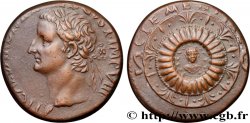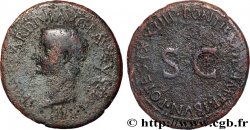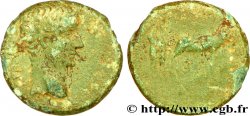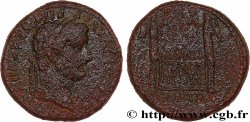v57_0235 - TIBERIO Coin monétaire
MONNAIES 57 (2013)
Начальная цена : 2 800.00 €
Назначить цену : 4 500.00 €
Цена реализации : 2 800.00 €
Количество ставок : 1
Максимальная предлагаемая цена : 5 500.00 €
Начальная цена : 2 800.00 €
Назначить цену : 4 500.00 €
Цена реализации : 2 800.00 €
Количество ставок : 1
Максимальная предлагаемая цена : 5 500.00 €
Тип Coin monétaire
Дата: c. 15-37
Монетный двор / Город: Lyon
Металл: iron
Вес: 83,15 g.
Редкость: UNIQUE
Комментарии о состоянии
Objet monétiforme en très bon état de conservation avec un denier enchâssé. Objet digne des plus grandes collections ou musées
Происхождение:
Ce coin viendrait d’une trouvaille effectuée à Paray-le-Monial au XIXe siècle et pourrait donc provenir de la trouvaille de 1863
Лицевая сторона
Аверс: легенда: TI CAESAR DIVI - AVG F AVGVSTVS.
Аверс: описание: Tête laurée de Tibère à droite (O*).
Аверс: перевод: “Tiberius Cæsar Divi Augusti Filius Augustus”, (Tibère César fils du divin Auguste, auguste).
Обратная сторона
Комментарий
Coin monétaire de faussaire pour le droit du denier de Tibère à la Paix (Livie) assise. Ce coin, haut de 27 millimètres, large de 26 millimètres pèse 83,15 g. La partie gravée fait 19 millimètres au niveau du grènetis. Ce coin est à notre avis composé de deux parties distinctes, probablement en fer trempé supportant la gravure et enchâssé dans un support tronconique de fer, certainement de fer doux, présentant un petit bourrelet dans la partie la plus large. Jean-Baptiste Giard dans son Catalogue des monnaies de l’Empire romain, II, de Tibère à Néron, Paris 1988 a recensé douze coins monétaires p. 7-8, pl. I. Quatre exemplaires proviennent de la trouvaille de Paray-le-Monial (Saône-et-Loire), trouvés en 1863 et conservés aujourd’hui au musée de la ville ou au musée des Antiquités nationales de Saint-Germain-en-Laye. Six coins ont été trouvés à Auxerre (Yonne) en 1799 dont quatre exemplaires sont conservés au Cabinet des médailles de la BnF et deux autres au musée monétaire de la Monnaie de Paris dont un est perdu. Un onzième exemplaire a été découvert à Vertault en Côte-dor, mais semble aujourd’hui perdu. Enfin le dernier a été trouvé à Ostie. Notre exemplaire a été retrouvé dans un buffet ancien situé dans une cave au hameau de "Pey" à Poule-les-Écharmaux (69) dans le Haut Beaujolais près de Villefranche-sur-Saône (Rhône) ce qui constitue une information très intéressante car sur douze coins, onze ont été découverts dans un rayon de deux cents kilomètres entre Auxerre et Paray-le-Monial. Notre coin s’inscrit dans la même veine.
Coin forgery coin for the right of the denarius of Tiberius to the Peace (Livia) seated. This coin, 27 millimeters high and 26 millimeters wide, weighs 83.15 g.. The engraved part is 19 millimeters at the grain level. This die is in our opinion composed of two distinct parts, probably in hardened iron supporting the engraving and set in a truncated cone-shaped iron support, certainly soft iron, presenting a small ridge in the widest part. Jean-Baptiste Giard in his Catalogue of the coins of the Roman Empire, II, from Tiberius to Nero, Paris 1988 listed twelve monetary dies p. 7-8, pl. I. Four examples come from the find of Paray-le-Monial (Saône-et-Loire), found in 1863 and preserved today in the town museum or in the Museum of National Antiquities of Saint-Germain-en-Laye. Six coins were found in Auxerre (Yonne) in 1799, four of which are kept in the Cabinet des médailles of the BnF and two others in the Monetary Museum of the Monnaie de Paris, one of which is lost.. An eleventh example was discovered in Vertault in Côte-dor, but now appears to be lost.. Finally the last one was found in Ostia. Our example was found in an old sideboard located in a cellar in the hamlet of \\\"Pey\\\" in Poule-les-Écharmaux (69) in the Haut Beaujolais near Villefranche-sur-Saône (Rhône) which constitutes very interesting information because out of twelve coins, eleven were discovered within a radius of two hundred kilometers between Auxerre and Paray-le-Monial. Our corner is in the same vein
Coin forgery coin for the right of the denarius of Tiberius to the Peace (Livia) seated. This coin, 27 millimeters high and 26 millimeters wide, weighs 83.15 g.. The engraved part is 19 millimeters at the grain level. This die is in our opinion composed of two distinct parts, probably in hardened iron supporting the engraving and set in a truncated cone-shaped iron support, certainly soft iron, presenting a small ridge in the widest part. Jean-Baptiste Giard in his Catalogue of the coins of the Roman Empire, II, from Tiberius to Nero, Paris 1988 listed twelve monetary dies p. 7-8, pl. I. Four examples come from the find of Paray-le-Monial (Saône-et-Loire), found in 1863 and preserved today in the town museum or in the Museum of National Antiquities of Saint-Germain-en-Laye. Six coins were found in Auxerre (Yonne) in 1799, four of which are kept in the Cabinet des médailles of the BnF and two others in the Monetary Museum of the Monnaie de Paris, one of which is lost.. An eleventh example was discovered in Vertault in Côte-dor, but now appears to be lost.. Finally the last one was found in Ostia. Our example was found in an old sideboard located in a cellar in the hamlet of \\\"Pey\\\" in Poule-les-Écharmaux (69) in the Haut Beaujolais near Villefranche-sur-Saône (Rhône) which constitutes very interesting information because out of twelve coins, eleven were discovered within a radius of two hundred kilometers between Auxerre and Paray-le-Monial. Our corner is in the same vein








 Cообщить об ошибке
Cообщить об ошибке Распечатать страницу
Распечатать страницу Отправить мой выбор
Отправить мой выбор Задать вопрос
Задать вопрос Consign / sell
Consign / sell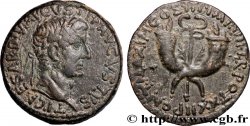
 Информация
Информация
